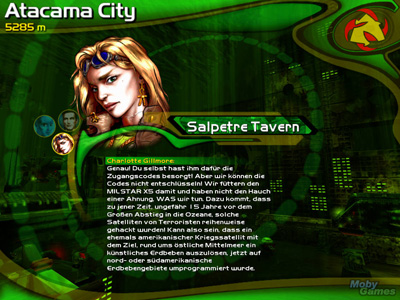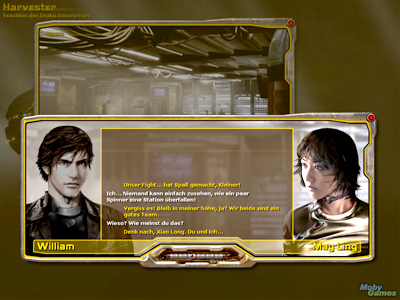Whenever i thought about or wrote down some of my gamedesign ideas in the last few years, i allways tried to focus on my personal technical abilities or on technologie than can be build with small teams and small budget.
as an example: 3d graphics is okay, but no ik animated objects. this and other limitations allways seemed as if it isn’t possible to create 3d characters with low budget. not from a artist point of view (it’s time consuming to create a high quality 3d character), but from a technology pov (even if it is a simple stylized character, all the technology needs to be fully available).
of course, krystian allways keeps the pov: 2d is more than enough, 3d is not necessary. but in 2d still the problem remains: fully animated characters (full body, complex animations) are one of the most complex game-content types.
but of course a lot of games since the eighties had characters involved, a lot of adventures and rpg’s with very emotional tied characters – and a lot of those games did not have best technical presentations of characters.
a lot of (especially japanese) rpg’s that allways wanted to create believable stories with beliveable characters created their own style of only showing heads, 2 frame talk animations (mouth open, mouth shut), synthetic sounds instead of voice acting, etc.
and now i’d like to start a discussion about what other ways of displaying characters are out there, done by others, liked and unliked by players. it’s really interesting how many stick-figure-like flashgames are popular today, but are their ones in which the player is really tied to the character. i mean action games like “N” have cool characters, but not really tied to the player. what if the N ninja meets others in a rpg/adventure world, other stickfigures – will good textual dialog be sufficient without more detailed visual representation of the characters?
i’d like to ask some more precise questions that we can elaborate or research on:
- how much needs to be visible of a character (head only, including shoulders, torso, complete body from hair to feet)
- in which context does a character need to be presented (floating in a frame ontop of the playfield, text in a adjacent frame, standing on the playfield)
- what kind of other decissions determine if a character should be displayed this or that way
- do characters become alive more by their visual representation, or by their textual dialog? what about simple text “to scroll through” or (fake) multiple choice dialogs?
as an example i like to tell what the schleichfahrt / aquanox series did:
- schleichfahrt (archimedean dynastiy) had simple text boxes in 3d prerendered rooms. but multiple choiced and over 100 npcs. people loved it.
- aquanox had icon-small faces (multiple in a group conversation) attached to a frame in which the dialog text was. no multiple choice, aprox 50 npcs. which hovered onscreen over an outdoor underwater look at a sub-station. people disliked it a lot.

- aquanox2 had jrpg like huge high quality faces (but unanimated!) + upper-torso hovering with text-frame over pre-rendered rooms. less than 15 characters and no multiple choice. people liked the characters a lot. but i tend to belive that this was more due to the good voice acting combined with the high quality artworks, and had nothing todo with the visual representation style.

btw: all 3 games have voice acting in a rather high quality – probably another point of discussion should open up on this topic alone, including the half life discussion about talking player characters. the ones in the ad/an series allways did so.
so, i stop writing now and ask: what do you think?






addendum:
i forgot another “question”:
-what ways of presenting characters on the playfield exist (2d sprites on 2d playfield, what about 2d sprites in 3d playfields, any good examples of unanimated 2d sprites in 3d, that still feel good beside looking total static)
A common mistake among KISD students who choose topics for their vordiplom is to choose a too broad question. They tend to choose topics like “Women in Comics” instead of “Women in SuperMan Comics” or even “Lois Lane in Superman Issue #13″.
I totally agree that the questions you mentioned are important but I believe the questions suffer from the same problem. I think it is too broad to be able to give a definitive answer.
Here is some food for thought though. Portrait vs. showing more of the body is called face-ism. There is already a lot of theory out there about it so you might want to dig into it. Generally, showing the face focuses on intimate feelings and intelligence. Showing the body shifts attention on.. well the body . Sexual and physical attributes. Also, it shows the cloths so you get a better idea of the social status. In Hotel Dusk you see part of the body and it shows a lot of gestures and body talk which is important for that game.
Reading text often slows the game down. Fahrenheit (Indigo Prophecy) has a dialogue system based on speech and multiple choice control with a time limit. It creates a very involving and lively dialoge.
I think text should be only used if you really need the flexibility like if you generate the text procedurally.
However, I do hate multiple choice dialogues. They are mostly fake anyway and generally, they are a symptom that the game designer run out of ideas. Games are about choices but those choices are made in high frequency and aren’t visible as choices. A multiple choice dialog gives you just one choice preceded and followed by a long non-interactive part. Also, you are totally aware that you are making a choice. On top of it, you realize what limited possibilites you have. More often then not, you want to say something which isn’t on the menu. This is a bad excuse for interactive dialog. Hotel Dusk is a wee bit better there. Phoenix Wright does it extremely well. But I will write some more about it in the GDR.
Characters can be also presented without any speech or text. Sims does that very well.
On the other hand, I believe you can present characters without a visual representation. I think HAL from Odyssey 2001 is a good example.
I think the way to cheap and convincing characters is to challenge everything you already know about characters and interaction with them.
Audio is definite a big part. I’m now about 5 hours into FFXII, so far I’ve seen only a handful characters properly and I must say that I don’t like how they modeled the males (especially Vaan and Vayne). But: the voice-over is nothing short of top notch, compensating a lot. Right now Balthier is actually managing to become something like a Han Solo-type character. Han Solo is cult so I’m being careful here, but Balthier does start to be the most likable so far.
Good example for 2D sprites on 3D fields: The Nippon Ichi SRPGs like Disgaea (or was it Disgeae?) etc and Ragnarok Online. But they are slightly animated, hmmm.
BTW, it is just speculation but I believe that the Aquanox characters were so unpopular because of a completly different detail:
Aquanox dosen’t show the place where you meet a character and where the talk takes place. The characters are kind of “hovering” in the air, not only visually but also mentally. Both Schleichfahrt and Aquanox2 are different. I was reminded of that when Yu-Chung showed me this gamasutra feature.